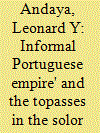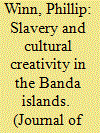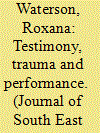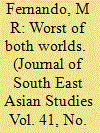|
|
|
Sort Order |
|
|
|
Items / Page
|
|
|
|
|
|
|
| Srl | Item |
| 1 |
ID:
099065


|
|
|
|
|
| Publication |
2010.
|
| Summary/Abstract |
This study of Timor and the surrounding islands between the sixteenth and eighteenth centuries provides evidence that, after the demise of the Portuguese Estado da India, an 'informal' or 'shadow' empire persisted but in uniquely localised ways. It describes the emergence of the 'black Portuguese' community known in Timor and the Solor archipelago as the Topasses. Their singular identity was based on the melding of indigenous and Portuguese blood and cultural forms. Their ability to access the sources of spiritual authority in both the Catholic and the Timorese domains assured their survival and that of the Portuguese in Timor until well into the twentieth century.
|
|
|
|
|
|
|
|
|
|
|
|
|
|
|
|
| 2 |
ID:
099067


|
|
|
|
|
| Publication |
2010.
|
| Summary/Abstract |
Much research has sought to understand why mixed communities in Indonesia have been torn apart by violent conflict. By contrast, little is known about how people live together successfully in the mixed, low-conflict communities that exist in abundance throughout the Indonesian archipelago. This paper explores the inter-communal relations in the multiethnic, Christian-Muslim coastal village of Oelua in Roti, Nusa Tenggara Timur province. Mechanisms of agreement across ethnic, religious and livelihood differences have shaped and reproduced a low-conflict community - including transfers of land, labour, technology and surplus; use of customary law and conflict management; and social mixing and interpersonal relations. The findings suggest that there are lessons to be learned from communities like Oelua about how to foster social and economic inclusion, which could inform national and regional political agendas concerned with governing difference in a post-New Order Indonesia.
|
|
|
|
|
|
|
|
|
|
|
|
|
|
|
|
| 3 |
ID:
099064


|
|
|
|
|
| Publication |
2010.
|
| Summary/Abstract |
In his influential edited volume Slavery, bondage and dependency in Southeast Asia, Anthony Reid suggests that long-term slave-based systems of production were absent from agriculture in Southeast Asia, and had an ambiguous presence at best in other areas of economic activity. The argument he presents suggests that indigenous slavery in the region merged into a 'kind of serfdom or household membership', a situation that continued after the arrival of Europeans whose slave-holding practices were profoundly shaped by the local traditions they encountered: 'slavery in the European colonies owed more to the Southeast Asian environment than to European legal ideas'. Reid's analysis is insightful and his conclusions persuasive. But he also notes a single exception to this general picture: 'the Dutch perkenier system for producing nutmeg in Banda with hundreds of slave labourers on large estates'. The nutmeg estates of the Banda Islands, in eastern Indonesia, provide a rare unequivocal example of a slave mode of production in Southeast Asia, and its sole instance in an agricultural context. The islands have a similar status within established accounts of slavery in Asia more generally. While some degree of geographic and historical variation is usually acknowledged, European slavery practices in Asia are regarded as distinct from colonial slavery in the New World, where European systems were imported wholesale. Against this conclusion, the perkenier system in the Banda Islands has been described as a form of exploitation 'unheard of in Asia', one that represented a 'Caribbean cuckoo in an Asian nest'. In other words, Dutch nutmeg cultivation in the Bandas constituted a New World style system of slavery operating in an Asian context.
|
|
|
|
|
|
|
|
|
|
|
|
|
|
|
|
| 4 |
ID:
099069


|
|
|
|
|
| Publication |
2010.
|
| Summary/Abstract |
This paper is a reflection on a number of theatre performances held in Singapore, each of which probed problematic or traumatic historical events occurring either in Singapore itself or in other parts of Southeast Asia. These avant-garde performances were inspired by or built around actual testimonies of individuals in ways which, for this author, suggest a striking fluidity in the boundaries between testimony and performance, one that raises difficult questions about performance ethics and the processes by which collective memories are shaped. The plays also made use of visual media: one had been recorded on video while others incorporated photographic and video materials into the actual performance. At the time I witnessed these plays, I had already become interested in the way that, over the course of the twentieth century, documentary films had come to play an increasingly important role in the recording of testimony concerning traumatic events. Testimony on film, I have argued, functions simultaneously as evidential trace, and as performative event. Films of testimony develop their own trajectories as they enter into the realms of public remembering. They preserve and extend the record of personal experiences, thereby adding them to the pool of collective memory about an event. Theatrical performances, too, develop their own trajectories through repetition, as Marvin Carlson's statement (cited above) suggests. But what exactly might be different when testimony is performed as drama before a live audience? What are the purposes of such performances, and what might be their possible effects upon both participants and audiences? Is the trace left by a live theatre performance inevitably more ephemeral than those captured on film, or might it be in some respects even more powerful? These are some of the questions I raise - without necessarily being able to present definitive answers - in what follows. I conclude by arguing that in the Singapore context, because censorship laws place very specific constraints on the making of documentary films with openly political content, in recent years theatre has been able to offer a slightly greater space than film as a medium for critical reflection. How theatre directors and actors have tried to use this space is a subject correspondingly deserving of our close attention.
|
|
|
|
|
|
|
|
|
|
|
|
|
|
|
|
| 5 |
ID:
099068


|
|
|
|
|
| Publication |
2010.
|
| Summary/Abstract |
This paper reads the debates of the Straits Settlements Legislative Council to trace the political contentions over policies affecting the Chinese community in Malaya. These contentions brought the Straits Chinese unofficials to engage the racial ambivalence of British rule in Malaya, in which the Straits Chinese was located as both a liberal subject and an object of colonial difference. Contrary to conventional historiography which portrays Straits Chinese political identity as one of conservative loyalty to the Empire, I show that the Straits Chinese developed multiple and hybrid political identities that were postcolonial in character, which would later influence the politics of decolonisation and nation-building after the war.
|
|
|
|
|
|
|
|
|
|
|
|
|
|
|
|
| 6 |
ID:
099066


|
|
|
|
|
| Publication |
2010.
|
| Summary/Abstract |
This paper deals with the consequences of the increasing commercialisation of the rice industry in west Indramayu from the mid-1880s to the late 1930s. Instead of prosperity as a result of growing rice for sale in a free market, local peasants found their survival being threatened by traders who had them bound to a vicious cycle of debts and who acquired much of the rice they produced. The rice growers in west Indramayu were impoverished far more than the peasants growing cash crops such as sugar elsewhere in Java.
|
|
|
|
|
|
|
|
|
|
|
|
|
|
|
|
|
|
|
|
|